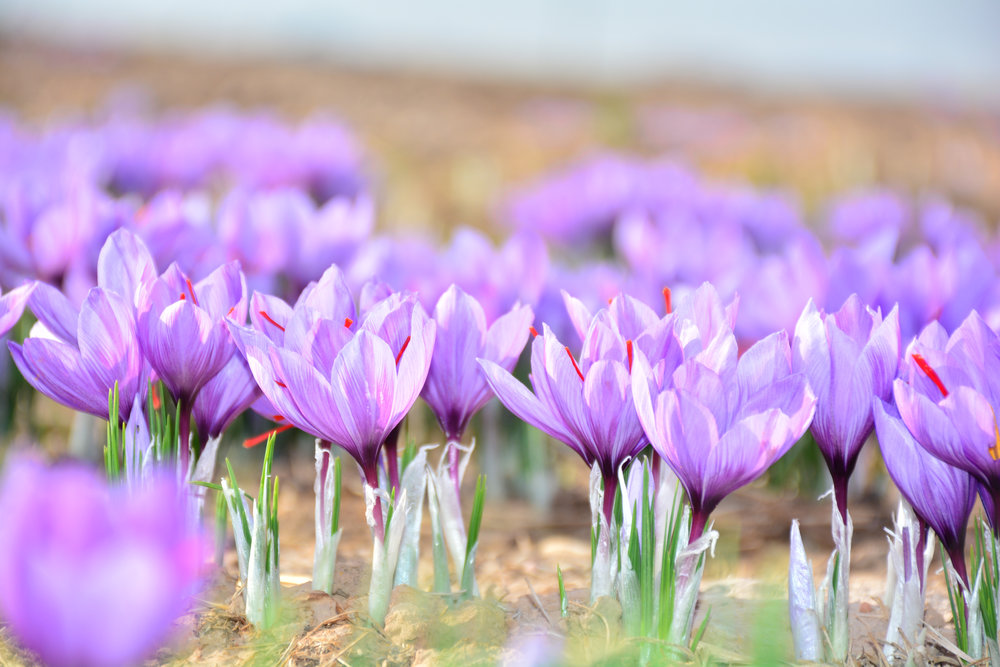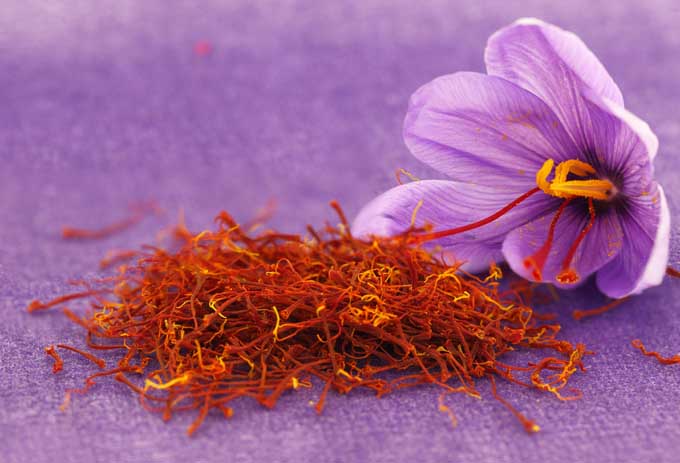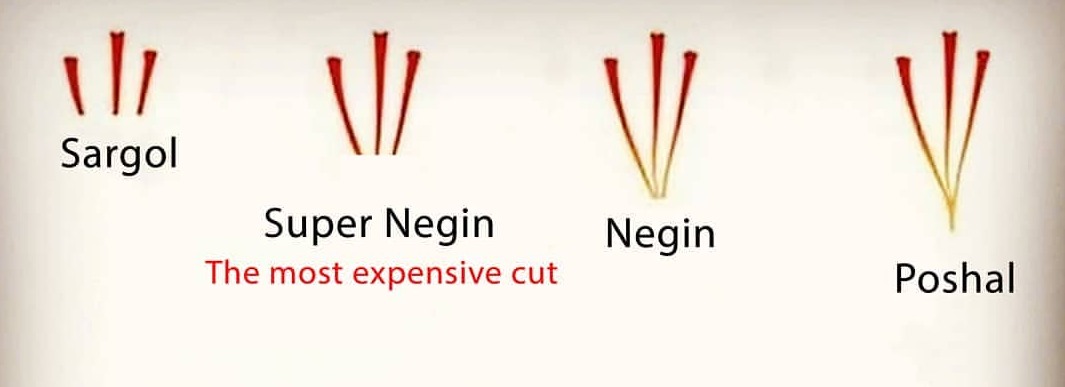
Saffron
Saffron is a spice derived from the flower of Crocus sativus ,commonly known as the “saffron crocus”. The vivid crimson stigma and styles, called threads, are collected and dried to be used mainly as a seasoning and colouring agent in food. Saffron has long been the world’s most costly spice by weight. Saffron and its magical power comes in many traditions and rituals. Iranians believe that saffron eradicates sadness and depression. It is associated with happiness, so they use it in many sweets and foods.
WHERE DID SAFFRON COME FROM?
Greeks claim that saffron came from their land first, tell that to any Iranian and you will get a laughter! A stronger hypothesis says that cultivation of saffron first took place in Iran. The arguments on origins of the precious spice are endless, so let’s take a look at the fact that currently, Iranians are the biggest producers of saffron in the world (85% of the world’s saffron grown in a year, roughly about 390 tons!) The number is huge, considering that every 500 saffron stigmas weighs only one gram.
HARVEST SEASON
Every year, the saffron harvest season begins in early November. While most other vegetation are gone, the bright purple flowers cover the fields and create an outstanding landscape in dry regions in Iran. Major saffron producers of Iran are located in the east side of Iran.

Saffron is one of the most expensive things. It is valuable as much as it is difficult to obtain. About 110/000 to 170/000 crocus flowers are required in order to obtain one kilogram of dried Saffron. Apart from the fact that curing process, soil type and harvest time and the importance of speed increase the value of this magical spice. Saffron has become one of the most expensive spices in the world due to high demand and limited production.
Iran can be considered as the cradle of the world’s saffron. Almost 90 percent of the world’s saffron is produced in Iran. Even many of saffron that are distributed with label of other countries are from Iran. saffron in Iran goes back 3000 years and still has its own power. saffron is known as the red gold of desert because its origin is Iran’s deserts.
Classifications of Persian Saffron

What is even more interesting is that there are four main classifications of Iranian/Persian saffron, these four classifications are based on the trim of the saffron thread. The four different trims of Persian Saffron are:
- Sargol: means “Top of the flower” in Farsi. Sargol is a sub-type of Persian saffron that derives from the very tip of the saffron thread. Hence, its name “top of flower.” It also has a specific, powerful aroma. Generally speaking, Sargol saffron is considered to be high quality due to its lack of Yellow or Orange threads. Sargol can be easily recognized thanks to its full and deep red color and short threads. On the downside, Sargol saffron often contains crumbs and broken threads.
- Super Negin: The most expensive and rare trim of Saffron. Super Negin saffron is known not only for being the most potent but also for its aesthetically pleasing features. Super Negin threads are longer in length and contain no yellow or orange threads. The threads are cut symmetrically and contain no crumbs. When comparing all the trims of Saffron, Super Negin is the most sought after for those who want the best of the best.
- Negin: When compared to Sargol and Super Negin, Negin is longer in length and contains some yellow and orange portions of the thread. To put it in simple words, the aroma, quality, and purity are still great but you do pay for some portions of the yellow and orange threads, which are lower quality.
- Poshal saffron is the cheapest and most commonly sold Saffron trim in stores. Since Saffron is so expensive, many distributors take advantage of consumers by selling them the orange and yellow portions of the thread to increase their profit margins. Since these yellow parts of the stigma contain no value, consumers end up paying much more in reality for a inferior product.
Iran export of Saffron
About 236 tons of saffron worth more than $325 million were exported from Iran during the year to March 2018, showing a growth of 56 percent compared to the figure for a year earlier.
The above figures show a 29.6% and 36.8% growth in weight and value respectively compared with year 2017.
The top export destination for Iranian saffron was the United Arab Emirates with $31.64 million, followed by China with $20 million, Spain with $16.54 million, Afghanistan with $9.74 million and Vietnam with $8.8 million.
The top export destination for Iranian saffron was the United Arab Emirates with $31.64 million, followed by China with $20 million, Spain with $16.54 million, Afghanistan with $9.74 million and Vietnam with $8.8 million.
WHEN DID SAFFRON GO TO INDIA?
Various conflicting accounts exist that describe saffron’s first arrival in South and East Asia. The first of these rely on historical accounts gleaned from Persian records. These suggest to many experts that saffron, among other spices, was first spread to India via Persian rulers’ efforts to stock their newly built gardens and parks.
They accomplished this by transplanting the desired cultivars across the Persian empire. Another variant of this theory states that, after ancient Persia conquered Kashmir, Persian saffron crocus corms were transplanted to Kashmiri soil. The first harvest then occurred prior to 500 BC. Phoenicians then began in the 6th century BC to market the new Kashmiri saffron by utilising their extensive trade routes. Once sold, Kashmiri saffron was used in the treatment of melancholy and as a fabric dye. Kashmire is currently the only estate in India that has the correct climate for Saffron cultivation.
In India saffron is an indispensable ingredient in many recipes of rice, sweets and ice-creams. It is used in Ayurvedic medicine and in religious rituals. In Saudi Arabia, a real Arabic coffee should have saffron and cardamom.
Also the Traditional Kashmiri legend states that saffron first arrived in the 11th or 12th century AD, when two foreign and itinerant Sufi ascetics, Khwaja Masood Wali and Hazrat Sheikh Shariffudin, wandered into Kashmir.
SAFFRON USES IN INDIA
Saffron is used as a culinary seasoning and to colour, cottage cheese, chicken and meat, rise, mayonnaise, liquors and cordials. It is also used in speciality breads, cakes, confectionaries, Mughlai dishes. Saffron is also used as a perfume in cosmetics. In medicine saffron is used in fevers, melancholia, and enlargement of liver and spleen. In Ayurvedic medicine it is used to heal arthritis, impotence and infertility. It has wide range of uses in Chinese and Tibetan medicines.



